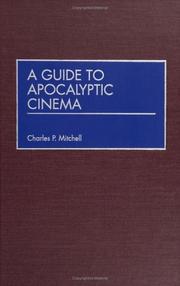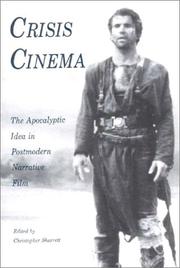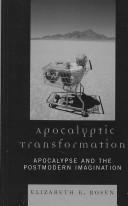| Listing 1 - 10 of 20 | << page >> |
Sort by
|
Book
ISBN: 1442260270 9781442260276 Year: 2015 Publisher: Lanham: Rowman & Littlefield,
Abstract | Keywords | Export | Availability | Bookmark
 Loading...
Loading...Choose an application
- Reference Manager
- EndNote
- RefWorks (Direct export to RefWorks)

ISBN: 0313315272 Year: 2001 Publisher: Westport (Conn.) : Greenwood press,
Abstract | Keywords | Export | Availability | Bookmark
 Loading...
Loading...Choose an application
- Reference Manager
- EndNote
- RefWorks (Direct export to RefWorks)
Apocalypse in motion pictures. --- Science fiction films --- History and criticism.
Book
ISBN: 9781978819849 9781978819856 9781978819863 9781978819870 9781978819887 Year: 2021 Publisher: New Brunswick, N.J. Rutgers University Press
Abstract | Keywords | Export | Availability | Bookmark
 Loading...
Loading...Choose an application
- Reference Manager
- EndNote
- RefWorks (Direct export to RefWorks)
"Movie audiences know exactly how the world will end because popular cinema has never stopped rehearsing the apocalypse. In this clear, concise account, Stephen Prince illuminates the appeal of apocalypse cinema, its roots in literary and religious tradition, its presence throughout cinema history, and the existential fears and anxieties that motivate it. In four elegant chapters, Prince examines the key threats to human existence that bring about world's end - collisions with giant asteroids, invasions by planet-devouring aliens, nuclear war, global warming and deadly pandemics. Touching on films ranging from The End of the World (1916), The Rapture (1991), Signs (2002), Armageddon (1998), Deep Impact (1998), Melancholia (2011), These Final Hours (2015), The War of the Worlds (1953), Invasion of the Body Snatchers (1956), Independence Day (1996), Annihilation (2018), Avengers: Infinity War (2018), Avengers: Endgame (2019) and many more, Apocalypse Cinema shows how apocalypse movies explore fundamental questions of existence that never go out of fashion"--
Apocalypse in motion pictures. --- Apocalyptic films --- History and criticism. --- Film
Book
ISBN: 2348046571 2348046350 Year: 2019 Publisher: Paris (9bis, rue Abel Hovelacque 75013) : La Découverte,
Abstract | Keywords | Export | Availability | Bookmark
 Loading...
Loading...Choose an application
- Reference Manager
- EndNote
- RefWorks (Direct export to RefWorks)
Omniprésentes, les fictions d'apocalypse – littéraires, cinématographiques, télévisuelles – imprègnent plus que jamais les tissus profonds de nos imaginaires. Apparues avec la Révolution industrielle, elles accompagnent les désillusions politiques des XIXe, XXe et XXIe siècles. Elles prennent racine dans un désespoir issu d'abord de l'échec de la Révolution française, puis d'une critique de l'idéologie du progrès. Bien avant qu'on forge les concepts d'anthropocène et de capitalocène, elles ont exprimé la prise de conscience de l'empreinte du capital sur la planète. Ainsi, contrairement à ce qu'on pourrait croire, elles ne sont pas nihilistes. Figurer la fin du monde, c'est opposer au présentisme et au fatalisme contemporains une autre conception du temps et une autre idée de la lutte. C'est chercher à faire émerger un horizon encore invisible, une promesse ouverte, indéterminée et en tant que telle nécessaire à l'invention politique : l'utopie.
Apocalypse in motion pictures. --- Apocalyptic literature --- History and criticism.

ISBN: 0944624197 Year: 1993 Publisher: Washington Maisonneuve Press
Abstract | Keywords | Export | Availability | Bookmark
 Loading...
Loading...Choose an application
- Reference Manager
- EndNote
- RefWorks (Direct export to RefWorks)
Apocalypse in motion pictures --- Motion pictures --- Postmodernism --- Social aspects
Book
ISBN: 9781443878807 1443878804 9781443872379 1443872377 Year: 2015 Publisher: Newcastle upon Tyne Cambridge Scholars Publishing
Abstract | Keywords | Export | Availability | Bookmark
 Loading...
Loading...Choose an application
- Reference Manager
- EndNote
- RefWorks (Direct export to RefWorks)
Apocalyptic Projections have been pondered since Biblical times. Theories abounded in an attempt to prepare for calamity and plan for the future. Worldwide concern regarding a twenty-first century apocalypse, related to the 2012 Mayan Apocalyptic prediction, sparked renewed interest. Even though the concept of apocalypse evokes images of total oblivion, threads of possibility and redemption offer a potential fabric of hope. The majority of the papers included in Apocalyptic Projections were p...
Book
ISBN: 2130810004 Year: 2013 Publisher: Paris : Presses Universitaires de France,
Abstract | Keywords | Export | Availability | Bookmark
 Loading...
Loading...Choose an application
- Reference Manager
- EndNote
- RefWorks (Direct export to RefWorks)
La bombe d'Hiroshima, premier engin atomique lancé sur une population civile, n'a pas seulement marqué à jamais la psyché japonaise : elle a aussi reconfiguré la flèche du temps pour l'ensemble de notre monde. C'est à l'exploration de cette ombre historique, projetée sur le plus commercial des médiums artistiques, le manga, qu'invite Pierre Pigot : comment des mangakas comme Miyazaki, Matsumoto ou Nakazawa ont forgé une esthétique capable de donner une apparence aux lourds fantômes de l'histoire ; comment, du Voyage de Ryû à L'École emportée, et de Princesse Mononoké à Albator, les mangas et dessins-animés ont exploré ces secrets de l'histoire humaine et ces hantises de la catastrophe, qui peuplent les coulisses de l'art depuis soixante ans ; comment, enfin, un manga aussi populaire aujourd'hui que One Piece dissimule au cœur de ses milliers de pages une idée secrète capable de nous donner les clés pour lutter contre cette prégnance de l'apocalypse. Apocalypse manga – ou le manga enfin sauvé de sa singularité orientale, et rendu aux mains de ses lecteurs.
Animated films --- Apocalypse in literature. --- Apocalypse in motion pictures. --- History and criticism.
Book
ISBN: 9004399445 1848884192 Year: 2015 Publisher: Oxford, England : Inter-Disciplinary Press,
Abstract | Keywords | Export | Availability | Bookmark
 Loading...
Loading...Choose an application
- Reference Manager
- EndNote
- RefWorks (Direct export to RefWorks)
The apocalypse's triumph is witnessed in the arts, literature, music, film, TV, and digital media thereby enabling us to view the very essence of Apocalypse as a cultural phenomenon.--

ISBN: 0739117904 1461632935 9781461632931 9780739117903 9780739117910 0739117912 Year: 2008 Publisher: Lanham, MD Lexington Books
Abstract | Keywords | Export | Availability | Bookmark
 Loading...
Loading...Choose an application
- Reference Manager
- EndNote
- RefWorks (Direct export to RefWorks)
Apocalyptic Transformation explores how one the oldest sense-making paradigms, the apocalyptic myth, is altered when postmodern authors and filmmakers adopt it. It examines how postmodern writers adapt a fundamentally religious story for a secular audience and it proposes that even as these writers use the myth in traditional ways, they simultaneously undermine and criticize the grand narrative of apocalypse itself.
American fiction --- Apocalyptic literature --- End of the world in literature. --- Apocalypse in motion pictures. --- Postmodernism. --- History and criticism.
Book
ISBN: 9798216182764 9798216182757 1440873399 9781440873393 Year: 2022 Publisher: Santa Barbara : ABC-CLIO,
Abstract | Keywords | Export | Availability | Bookmark
 Loading...
Loading...Choose an application
- Reference Manager
- EndNote
- RefWorks (Direct export to RefWorks)
"This volume is a resource for students of all levels who are interested in learning more about apocalyptic and dystopian narratives and the complex ways that they reflect the cultural conflicts, fears, and anxieties of the societies in which they were created and serve to offer critiques and responses to those same phenomena"-- ǂc Provided by publisher.
| Listing 1 - 10 of 20 | << page >> |
Sort by
|

 Search
Search Feedback
Feedback About UniCat
About UniCat  Help
Help News
News